Wednesday, 6 July 2016, Gortys, Phaistos, and Matala—the midweek excursion
Written 7 July 2016
The meiofauna folks have long since figured out that after two solid days of 15-minute talks, everybody's brain is fried, and a break is in order. As a result, Wednesday is usually set aside for a full-day group excursion. This time it was a bus tour of Gortys (site of Christianity's arrival in Crete and of the "great inscription"), Phaistos/Faistos/Festos (the royal palace where the disk comes from), and Matala (world epicenter of hippie-dom for a time). Françoise did not approve—"they could take you to Knossos but they're taking you to Matala?!"
So after breakfast as usual at the hotel, we formed up in the lobby and boarded buses (ours was #53; the other one was #61; it's a big tour company) for a 9 a.m. departure, headed south.
On the way, our guide regaled us with information. For example, the current population of Heraklion is 180,000. The elevation of Agia Varvara, the highest point on our route between the coasts, is 580 m. The two churches facing each other in center of the town (which is all strung out along a single street/road and is therefore hailed as the "longest town" in Crete) are both both dedicated to St. Barbara. (Greek "beta" is sometimes transliterated as "v" and sometimes as "b," and I'm pretty sure "agia" means "(female) Saint")
Crete produces 10% of the olive oil in the world, from about 30 million trees, which need a lot of water. Cretans olive-oil consumption is the highest in the world, ca. 30 kg/year per capita.
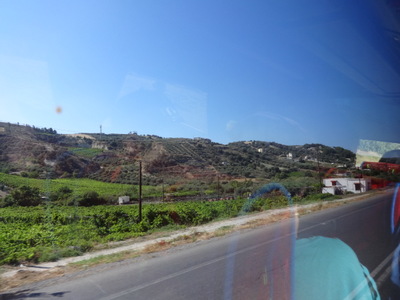
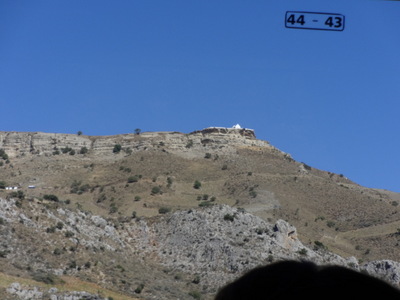 Only one village in southern crete produces wine (I didn't catch the name); all the other grapes we saw on our drive will become sultana raisins. The bright green areas in the foreground in the left-hand photo are grape vines. The rows of darker green spots farther away are olive trees.
Only one village in southern crete produces wine (I didn't catch the name); all the other grapes we saw on our drive will become sultana raisins. The bright green areas in the foreground in the left-hand photo are grape vines. The rows of darker green spots farther away are olive trees.
About 95% of Crete's population is eastern orthodox. The island does have four Catholic churches, to serve tourists and non-Greek resident spouses of Greeks.
Just before Agia Varvara, we passed this hilltop chapel. Chapels are everywhere on Crete, from roadside ones that two people could get into if they crouched, to little shrines the size of birdhouses, to hilltop sites like this one.
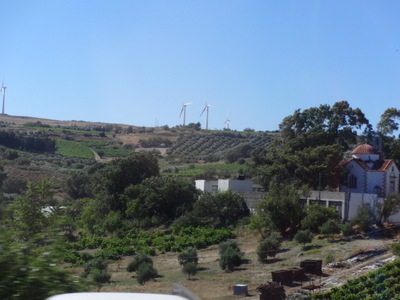
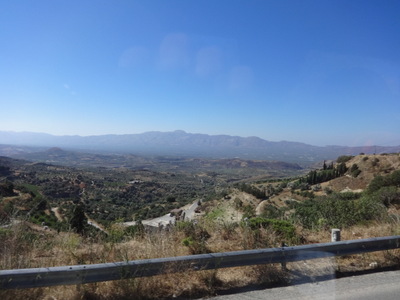 As the photo at the left shows, the countryside is heavily cultivated, almost entirely in grapes and olives. Scrubby (but bearing) almond trees were planted around the edges of some olive groves, but I saw no actual almond groves. (We did see one prickly-pear grove, all set out in rows, with drip irrigation lines!)
As the photo at the left shows, the countryside is heavily cultivated, almost entirely in grapes and olives. Scrubby (but bearing) almond trees were planted around the edges of some olive groves, but I saw no actual almond groves. (We did see one prickly-pear grove, all set out in rows, with drip irrigation lines!)
When we reached the edges of the Mesara Plain, we saw some orange groves. Most of the major roads are lined for long stretches with oleander in a variety of colors, in full bloom when we were there.
In the right-hand photo, you can see the plain in the distance—it's the green area with elongate white blotches (ranges of greenhouses) just in front of that last gray range of hills in the background.
I saw some big birds of prey soaring during the drive. I've looked at a few photos on line and I'd like to think they were Cretan golden eagles (Aquila chrysaetus), but I can't be sure. (So that's where our hotel chain got its name and why its logo is a big bird in flight . . .)
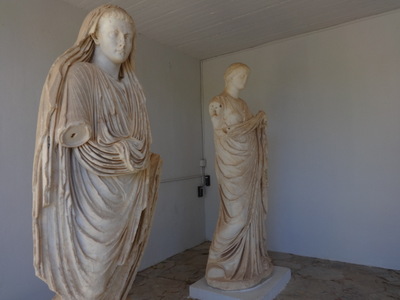
 On crete, the stone age began in the 7th millenium BC and ended in 2600 BC, when the pro-Hellenists brought a new language and contributed place names ending in -os or -is (e.g. Knossos, Phaistos); their leader gave his name to the first site we visited, Gortys (also spelled "Gortyna" and several other variations).
On crete, the stone age began in the 7th millenium BC and ended in 2600 BC, when the pro-Hellenists brought a new language and contributed place names ending in -os or -is (e.g. Knossos, Phaistos); their leader gave his name to the first site we visited, Gortys (also spelled "Gortyna" and several other variations).
While the guide bought our tickets (two busloads, remember), we strolled around the front courtyard looking at some unlabeled marble statuary displayed behind bars. All the heads were gone (were the necks just the most fragile part, or was that some sort of religious disagreement?) except for these two (left photo) and this oversized seated guy (right photo).
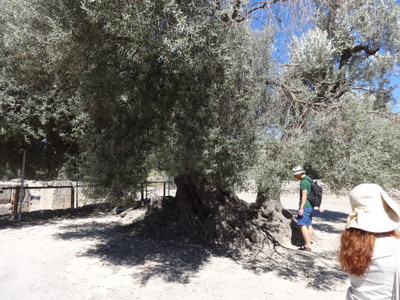
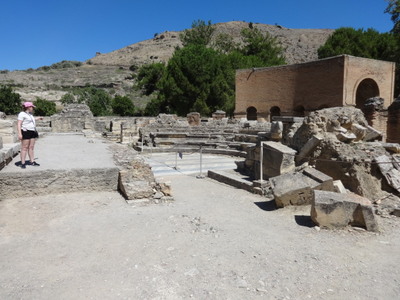 Gortys has more than one claim to fame, from different periods.
Gortys has more than one claim to fame, from different periods.
In 2nd and 3rd millenia BC, Gortys was overshadowed by the capital, Phaistos, and only became more prominent later, under the Romans.
In the 4th or 5th century BC (the Hellenistic period, I think; still before the Romans), a round building stood in the agora (marketplace) that was intended as a gathering place. The acropolis and temple of Athena were up on a hill (now named for St. John) behind it. On the building's walls were engraved a code of laws, consisting of perhaps 600 lines, in an alphabet and language that have since been deciphered. It was pretty thorough, dealing with marriage, divorce, adoption, trading, etc. Interestingly, it read in "ox-ploughing" pattern. That is, the first line was read left to right; the second, right to left; the third left to right again; and so on. The building was abandoned after the classical period.
When the Romans showed up in the 1st century AD, they (as was their wont) built an odeon and a theater, and in constructing the odeon, they came across the abandoned building with its law code, called (at least now) "the great inscription" or "the queen of inscriptions." They couldn't decipher the inscription, but they preserved part of the building (including about 240 lines of the inscription), and incorporated it into the structure of the odeon. (The guide told us that the difference between an odeon and a theater is that an odeon was always covered, whereas a theater wasn't, necessarily.) They brought the marble for floors and facings from the cyclades (an archipelago southeast of mainland Greece, where the best marble still comes from). The headless statues on display near the entrance were mostly from niches around the back of the odeon.
A larger theater, not as well preserved, is visible on the hillside beyond the odeon.
At some point, the apostle Paul was travelling to Rome, accompanied by his student Titus. They were shipwrecked on Crete, and Paul occupied his time by converting and baptising some of the locals, thus establishing the Christian church for the first time on the island. He then travelled on to Rome, but he left Titus (later St. Titus) behind to become the first bishop at this location.
The huge old olive tree at the right above is one of three, all 400 to 500 years old. In the 6th century AD, a Byzantine church (Crete was in the eastern division of the Roman empire, Byzantium) was built on the site (on top of an older one), right next to the odeon, and the guide told us that the designer of the church specified the locations of three olive trees to be planted next to it. These are not the originals, but they are supposed to mark the three original spots. It had a three-aisled nave, now in ruins, but the three apses at their eastern ends still stand. You can still see the outline of the narthex, where the unbaptised were permitted to come to hear the preaching, but only the baptised could enter the nave proper. I was surprised to learn that the platform in the central apse, which would have held the altar, was called the "vima" or "bima"! That's got to be the same word still used for the central platform in a synagogue.
That church has long been called the church of St. Titus, because he was known to have been buried in the largest church in the area, although the locals treated it as dedicated to the Virgin Mary instead. Only much later did archaeologists discover a much larger nearby church (with a five-aisled nave) of the right period and conclude that that was the real church of St. Titus. The one we saw was probably dedicated to the Virgin Mary from the start.
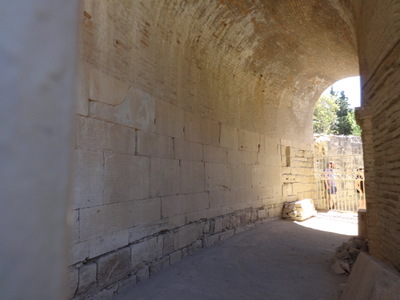
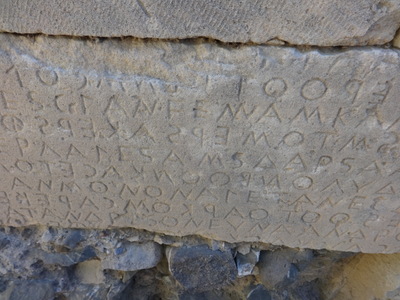 Here (left) is a view of the curved wall bearing the bulk of the preserved inscription. The stones making up the rest of it are scattered. As always, when when an ancient stone structure falls into disuse, people scavanged the stones to use in other construction.
Here (left) is a view of the curved wall bearing the bulk of the preserved inscription. The stones making up the rest of it are scattered. As always, when when an ancient stone structure falls into disuse, people scavanged the stones to use in other construction.
The right-hand photo is of a single stone at about knee level, out of sight to the left of the other photo, where the Romans used it as part of another section of wall. In the close-up, you can see the letters clearly.
Other stones bearing such passages have been discovered incorporated into buildings for miles around, and a couple were even taken home by archaeologists and deposited in the Louvre, where they remain. Several were incorporated into the walls of a mill race that ran right behind the original inscribed wall and served a water mill a few yards away.
In the 19th century, an archaeologist (I think it was Federico Halbherr, who succeeded in diciphering the whole inscription in 1884) couldn't get the mill owner to stop the flow through the mill race long enough to transcribe the portion of the text that was below the water line. Eventually, he recruited a rich patron to buy the whole mill so that he could stop the water and get at those lines! The ruins of the mill are still there.
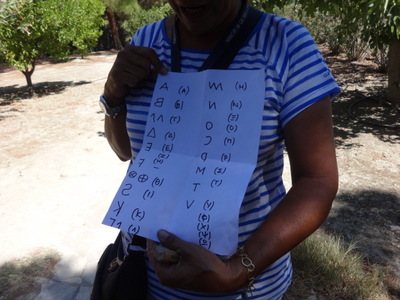
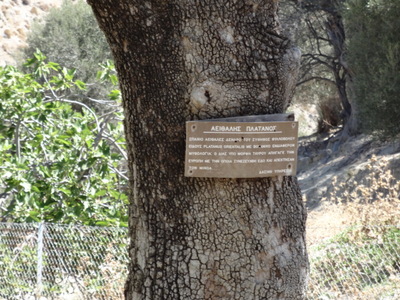 At the left here, the guide holds up a hand-made chart showing the correpondence between the modern/classical Greek letters and the smaller number of letters used in the great inscription. She gave the chart away to one of the group after talking about it, and it later turned up in the Swedmark Fund raffle!
At the left here, the guide holds up a hand-made chart showing the correpondence between the modern/classical Greek letters and the smaller number of letters used in the great inscription. She gave the chart away to one of the group after talking about it, and it later turned up in the Swedmark Fund raffle!
Now another claim to fame, this one a little shakier. Remember from art courses and museum visits all those paintings sculptures of the rape of Europa? That's the one where Zeus takes the form of a bull to carry off Europa, a young woman of Phoenician extraction and the ruling family of Tyre. Anyway, it turns out that where he took her was Crete, where she gave birth to three sons—Minos, Rhadamanthus, and Sarpedon—who became the first three kings of Crete and founded the Minoan civilization. (I wondered aloud later whether they were born all at once or after successive pregnancies—the guide didn't specify—and David pointed out that, given usual protrayals of Zeus's amorous attention span, they must have been triplets). Minos set up shop at Knossos, site of the largest of the three Minoan palaces; Rhadamanthus at Phaistos, site of a slightly smaller one; and Sarpedon at Malia (north coast, east of Heraklion), site of the smallest (at only 7500 square meters!).
The story is quite specific that she gave birth to these sons under an evergreen plane tree. Plane trees are general deciduous, but occasionally on Crete (and only there), you come across one that doesn't lose its leaves in winter. The photo on the right above is of the trunk of such a tree, which is located just a few yards from the odeon and St. Titus church. The plaque serves to point it out, among the other plane trees on the site. (It's a Platanus orientalis, the oriental/eastern plane tree; the common North American sycamore is P. occidentalis, the occidental/western plane tree; the evergreen variant is P. orientalis var. cretica).
The specimen you see here is the only evergreen individual in the entire valley of the Mesara Plain, so locals thought it was the only one anywhere and declared it the very tree under which King Minos was born (although the tree is actually only a couple of hundred years old). Older village women still consider it sacred to the gods/saints/spirits that oversee childbirth and come to pick a few leaves from it to make tea for their pregnant daughters.
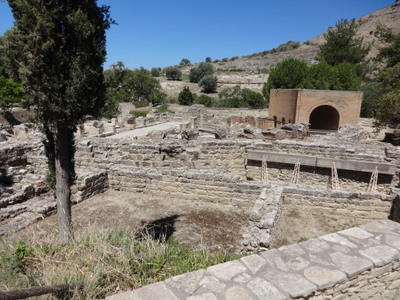
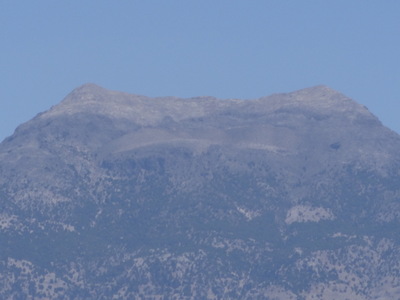 Here's wider shot of the odeon. The great inscription is inside the brick structure, and the white band across the hillside behind it (view bounded on both sides by trees) is the remains of the seating of the larger theater.
Here's wider shot of the odeon. The great inscription is inside the brick structure, and the white band across the hillside behind it (view bounded on both sides by trees) is the remains of the seating of the larger theater.
Back on the buses, we continued onward to Phaistos, site of the second-largest Minoan palace, after Knossos. From the site, we had this view of Mt. Ida (456 m), whose double peak (telephotoed a little here) resembles the "horns of consecration," a stylized motif ubiquitous in Minoan art, from inch-high ones on the rims of jars to 10-footers on the tops of palace walls. They represent the horns of the sacred bull and represent the king's dual power, over both church and state.
The black spot on the mountainside below the right-hand "horn" is the entrance to a huge cave that served as a place of offerings to gods and goddesses of several successive civilizations. A whole style of pottery is named for the offering jars found there.
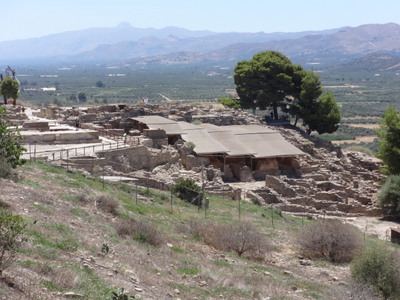
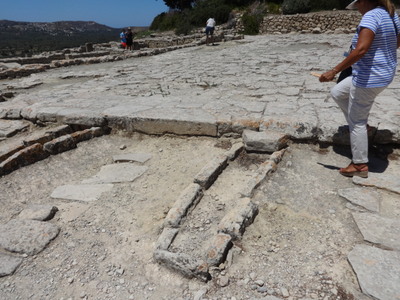 Here, at the left, is a view of the ruins of the palace of Phaistos as you approach the site on foot. The whole thing is located on the top of the Hill of Castri, documented to be the hottest site on Crete, and the weather was trying to convince us of that. Fortunately, it's also quite windy, so we had a nice breeze. The rooftops are shelters built to protect parts of the ruins. At Knossos, I'm told, considerable areas of the palace have been reconstructed, but here at Phaistos, the emphasis has been only on stabilizing and preserving. In fact, some of the areas we walked on had been excavated, studied, and then covered up again.
Here, at the left, is a view of the ruins of the palace of Phaistos as you approach the site on foot. The whole thing is located on the top of the Hill of Castri, documented to be the hottest site on Crete, and the weather was trying to convince us of that. Fortunately, it's also quite windy, so we had a nice breeze. The rooftops are shelters built to protect parts of the ruins. At Knossos, I'm told, considerable areas of the palace have been reconstructed, but here at Phaistos, the emphasis has been only on stabilizing and preserving. In fact, some of the areas we walked on had been excavated, studied, and then covered up again.
At the right is part of a courtyard (the palace had three large ones), crossed by a "processional way," crossing the photo from left to right just beyond the guide's feet. Each courtyard had one; they were probably simply slightly raised walkways that allowed pedestrians to cross dry-footed when the courtyard was flooded with rain water, but they were also sometimes used for actual processions. The rectangular arrangement of stones projecting from it toward the camera is a grave, much later than the time of the palace, which reused some of the stones from the pavement.
Written 11 July 2016
The guide explained that the shallow round pits we saw rows of here and there were intended to receive the bottoms of wooden pillars, made of the trunks of cypress trees, which supported some of the roofs.
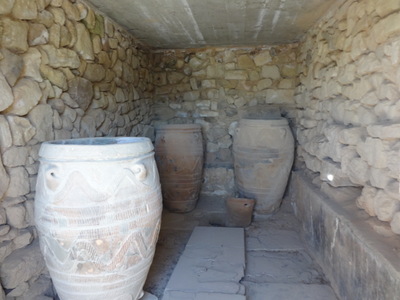
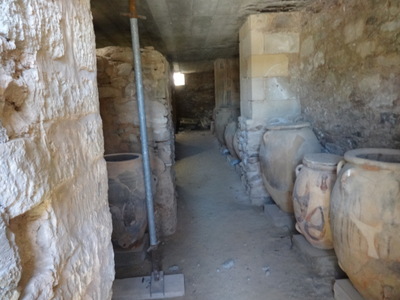 Next, we walked through the storage area of the palace. Small, windowless, stone-walled rooms lined both sides of a corridor. Most of them were empty, but a couple, shown here, have been restored to their original conjectured arrangement—that is, the same jars that were there when they were found have been put back, in the same places.
Next, we walked through the storage area of the palace. Small, windowless, stone-walled rooms lined both sides of a corridor. Most of them were empty, but a couple, shown here, have been restored to their original conjectured arrangement—that is, the same jars that were there when they were found have been put back, in the same places.
The room shown at the left is thought to have been for liquid storage (oil, wine, etc.), because it has a well in the floor, designed to catch and collect spills from cracked or broken containers, which could then be filtered and reused. It is also furnished with a round clay stool. Apparently the Minoans were quite short, well below today's average height, and would have had trouble reaching into those big jars.
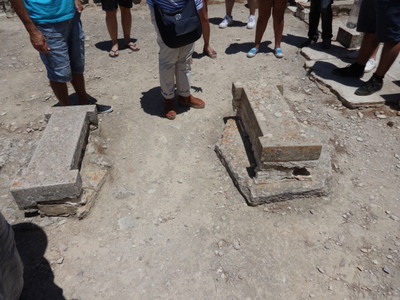
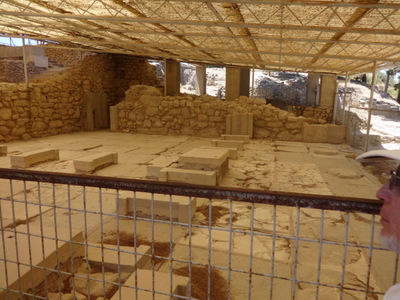 The left-hand photo here shows the Minoan equivalent of those big folding room dividers that can be used to separate cavernous hotel ballrooms into three or four smaller meeting rooms.
The left-hand photo here shows the Minoan equivalent of those big folding room dividers that can be used to separate cavernous hotel ballrooms into three or four smaller meeting rooms.
Doors are thought to have been made of oiled animal hides stretched on wooden frames. These "I"-shaped structures (two of a series of three separating a room from a corridor) are the bases of piers that would have reached from floor to ceiling. They've been capped with concrete both to protect them from erosion and to show their original I-shaped cross section. The width of the indentation between the top and bottom cross-pieces of the "I" is exactly half the distance between each pier and the next. A pair of oiled leather doors would have been hung between each pier and its neighbor, such that, when they were closed, they formed a wall between the room and the corridor. When they were open, the door swung back to fit neatly into the spaces along the sides of the "I," leaving the room separated from the corridor only by the smoothsided piers.
At the right is the king's chamber (sheltered by a modern canopy). Kings's appartments were always in the east wing of Minoan palaces (the "big three" were not the only palaces on the island), except here, where they are at the northeast corner, probably to catch the prevailing winds in the hot season (the palace is built on the Hill of Castri, documented to be the hottest place on the island) and for the spectacular view of Mt. Ida.
To take particular advantage of those prevailing winds, the king's chamber had only two walls. The other two were made up of those "I"-shaped piers, whose door panels could be folded away in hot weather, leaving the room open to the air on those two sides, a few yards from a steep drop to the valley below. In winter they could be closed so that the room could be heated by braziers.
This arrangement reinforced the guides's descriptions of the Minoans as a very peaceful people. The museums are full of pottery, figurines, and ornament, but not weapons. The palaces were built of stone for permanence, but they weren't fortified.
Rooms had only small windows. They were mainly lighted by skylights—yes, completely open holes left in the ceiling for the purpose. Below the skylight was a shallow well in the floor, to catch rainwater, and a gutter that conducted the water outside. I'm betting those skylights had curbs around them on the roof, so that all the water that landed on the roomf didn't come into the room, just the drops that fell directly in. We were shown huge cisterns into which most rainwater was conducted from roofs and courtyards, for use in the very dry summers.
The royal appartments are a couple of feet lower than rest of the palace. They probably survived the first of the two major earthquakes that did in the Minoan empire. The rest of the palace was rebuilt a couple of feet higher, on top of the ruins of the previous construction. Archaeologists have excavated parts of those ruins, then filled the soil and rubble back in to protect them. We walked over some.
In the "industrial" portions of the palace, we saw the room where copper and bronze were smelted. It also included a pottery kiln. The guide said that luxury imports included gold from Egypt, amethyst and crock crystal from the islands of the Aegian, lapis lazuli from Asia Minor, copper from Cyprus, and tin from sardinia (bronze was made locally). Iron was known but considered as precious as gold and was used only in jewelry. These were paid for mainly with proceeds from export of agricultural products.
When animals were sacrificed to the Minoan goddess (I think they had just one, who was the goddess of the earth and fertility), the meat was cooked and distributed, and the bones were worked into tools or discarded. The blood was collected and placed in tall, conical jars, with openings at the bottom to let the blood soak directly ito the ground, fertilizing it and pleasing the goddess.
More information from the bus and palace guides:
- 2000 BC, when the first palaces were built, is considered the beginning of the Minoan empire.
- A writing system called Linear A, from about 1800 BC, still hasn't been deciphered.
- Ca. 1700 BC, a major earthquake badly damaged all of the big three palaces.
- The palaces were rebuilt, and 150 years after that reconstruction is considered the peak of the Minoan period.
- In ca. 1600 BC another big earthquake wrecked the palaces again, and the Minoans never really recovered.
- The Myceneans invaded and took over.
- Some believe that the explosion of the volcano on Santorini was so powerful that it left the Minoans helpless to repel invasion. An alternative view is that only economic destruction, and not physical, weakened the Minoans and let the Myceneans in.
- The palaces were abandoned after the second earthquake.
- In Minoan times, winter was probably about the same temperature as now, but summer was hotter. Frescos portray more southerly plants than are now found on Crete.
From Phaistos, the buses took us down to plain and on to Matala. Looking down from the mountain roads, we could see long ranges of white greenhouses in the flat area. The guide said the Cretans were beginning to grow mangos, papayas, and even coffee in greenhouses there. They already produce bananas, but they're much smaller than the imported ones.
I could see rolls of black plastic mesh stored in forks of many of the olive trees we passed. Presumably that mess is spread under the trees to catch the olives during the harvest. I could also see wheel tracks in some of the groves, but not in the steeper ones, so I wonder whether the trees are still shaken by hand in some places but mechanically harvest (or at least mechanically shaken in others), but I never got the chance to ask.
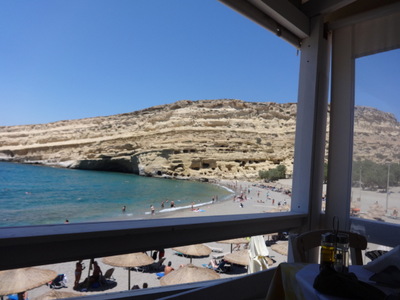
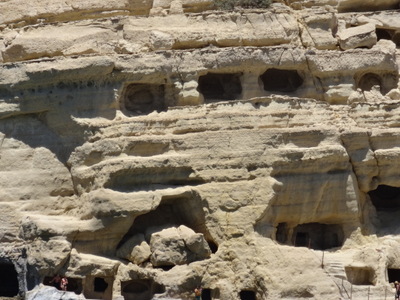 Françoise was pretty disgusted when she heard that our day's excursion would end up at Matala—"They're not taking you to Knossos, but they're taking you to see the stupid hippie caves?!" Not knowing anything about our destinations at the time, we assured her that they were probably taking us to a place of interest to meiofauna collectors, like a beach with plenty of nematodes and copepods. As it turned out, of course, Gortys and Phaistos were the real point of the trip. Matala, with its "stupid hippie caves," was just where we got the chance to have lunch, shop a little, and for those who wanted to, go swimming in the sea.
Françoise was pretty disgusted when she heard that our day's excursion would end up at Matala—"They're not taking you to Knossos, but they're taking you to see the stupid hippie caves?!" Not knowing anything about our destinations at the time, we assured her that they were probably taking us to a place of interest to meiofauna collectors, like a beach with plenty of nematodes and copepods. As it turned out, of course, Gortys and Phaistos were the real point of the trip. Matala, with its "stupid hippie caves," was just where we got the chance to have lunch, shop a little, and for those who wanted to, go swimming in the sea.
Here you see the notorious manmade neolithic caves, in the cliff just beyond the beach, both as we saw them from our restaurant table and enlarged by telephoto. Apparently, some backpacking hippies discovered them in the 1960's when Matala had probably never seen so much as a tourist and moved in. They invited their friends, and the place became a mecca for flower children. Joni Mitchell even lived there for a while. The colony persisted for quite a while, and I gather that the locals regarded them hippies with a sort of amused tolerance. Eventually, though, the drug scene got a little too far out of hand, and the cave dwellers were politely invited by the police either to clean it up or to move on. That 20 or 30 years ago, and I'm told that the last certified hippie only moved out quite recently. Now the caves are roped off, although you can buy a ticket to visit some of the lower ones. We didn't.
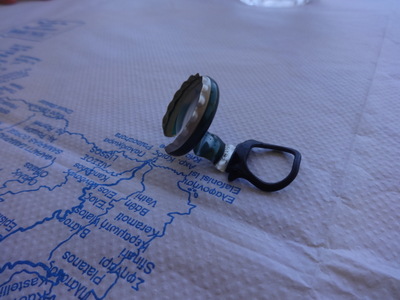
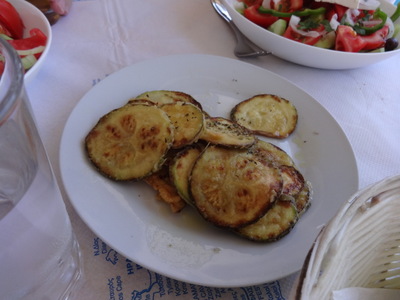 What we did was to prospect restaurants until we found one that suited us (Alexis Zorba's Family Taverna) and settle in for a leisurely lunch with a colleague.
What we did was to prospect restaurants until we found one that suited us (Alexis Zorba's Family Taverna) and settle in for a leisurely lunch with a colleague.
The left-hand photo shows something I hadn't seen before—a pop-top bottle cap. Do we have those in the states?
The right-hand photo is our shared appetizer, fried zucchini slices, which were excellent.
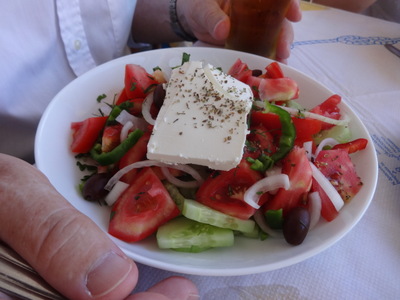
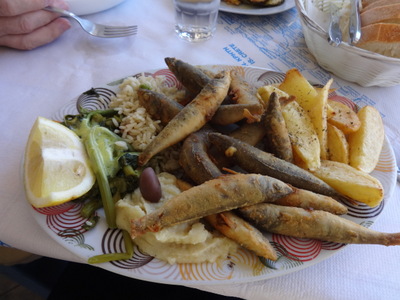 David and Michaela both ordered Greek Salad, which, in Greece, never contains lettuce. It's just tomato, cucumber, optional bell peppers and onions, and feta, with some oregano and a light vinaigrette.
David and Michaela both ordered Greek Salad, which, in Greece, never contains lettuce. It's just tomato, cucumber, optional bell peppers and onions, and feta, with some oregano and a light vinaigrette.
I ordered what was advertised as "whitebait fish" but turned out to be something much larger. Whitebait are so small you can eat the whole thing, like fish French fries, but these had heads and spines way too hard to eat. Yummy, though. Anchovies, maybe? They came with a whole assortment of accompaniments: lemon wedge, field greens with lemon-butter sauce, flavorful rice pilaf, outstanding lemon-and-olive-oil mashed potatoes (topped with a whole olive), and French fries (yes, that's two potatoes and rice).
Also on the menu was a grilled fish called, in both French and English, "bogue." Say what? I looked it up later; it's Boops boops, which I had not known was considered a food fish.
After lunch, we strolled around looking at the sovenir shops. One lady tried very hard to sell me cellophane bags of dried "mountain tea" and "dittany," and I was tempted, as they make very good tea, but the USDA would have a conniption if I tried to bring big bags of dried plants like that into the country. The mountain tea (Sideritis syriaca, is probably what David was served for lunch the day we went to Eleftherna. Dittany is Origanum dictamnus, a congener of oregano.
For long stretches, the sidewalks and pedestrian roadways were painted with "hippie-appropriate" themes—marijuana plants, gaily decorated VW minibuses, peace symbols, flowers, guitars, etc.
In one shop, I found a Cretan cookbook that friend and colleague Jean-Yves Guilvard. Jean-Yves, a recently retired fisheries inspector for the EU, is the husband of Laurence Guidi-Guilvard, David's host at Villefrance-sur-Mer when he did his sabbatical there. If he'd been with us in the restaurant, we would certainly have been able to tell me what a "bogue" was—he knows the name of every fish in every European language and can identify them at sight, whether alive or fried. He's been cooking out of the French version of this cookbook for years—they have a vacation home in Greece, though not on Crete. I bought the English version and was gratified, when I checked the price later in a shop back in Heraklion, that I saved over 3 euros by buying it in Matala.
EVentually, we piled back into the buses (glad for the air conditioning after hiking around in the heat) and drove back to Heraklion. On the way, we passed Mt. Yioukltas, which has a profile reminiscent of an old man snoring on his back with his mouth open. Zeus was said to die every fall, be buried on that mountain, then be reborn in the spring, such that the mountain gradually took on the shape of his head. Other localities make competing claims to be his burial place. We reached the hotel about 6 p.m.
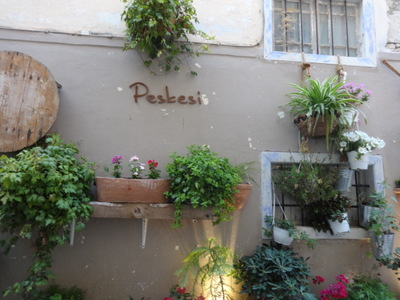
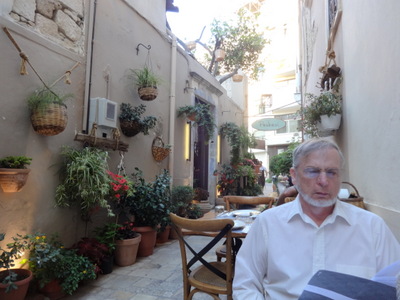
Our friends the Warwicks had come to Crete early to do some sight-seeing with relatives, and since the first day of the meeting, they had been raving about a restaurant called Peskesi that emphasizes traditional Cretan cooking (some recipes dating from Minoan times), used organic products from named suppiers, grows its own vegetables, etc. We accordingly decided to try the place. Google mapped it as being in the middle of a block, so I wasn't sure where to find the entrance, but it wasn't far, so we set off and had no trouble finding the door. Its outdoor terrace tables were already full of young people from the meiofauna conference, who assured us as we entered that the place was great. The waiter showed us inside, into a whole warren of little rooms, and finally out the other side of the block (it really is in the middle) into a tiny pedestrian alley lined with tables and seated us there.
As you can see in the two photos, the alley was heavily decorated with plants and flowers in mismatched pots and containers. The first shot is across the table and along the alley; the second is turned 90 degrees, straight across the alley.
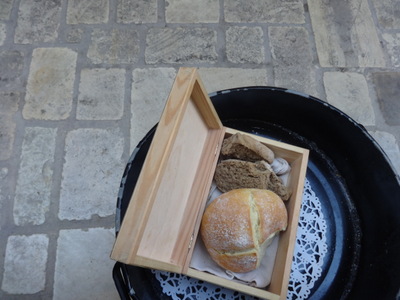
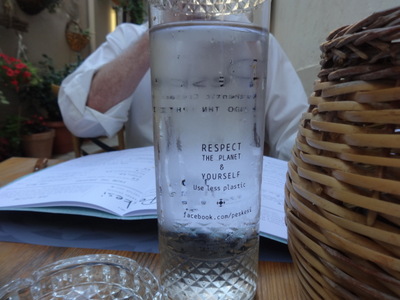 Bread was served in wooden boxes with hinged lids; our table was so small that they put the box on a little stool next to it.
Bread was served in wooden boxes with hinged lids; our table was so small that they put the box on a little stool next to it.
The water (from the tap) came chilled in tall glass bottles with the restaurant's name and slogan on the front and, on the back, this note saying, "Respect the planet and yourself; use less plastic," together with the restaurant's facebook address.
While we studied the menu, we were served a large saucer of tsatsiki to go on the bread. I couldn't definitely identify the herbs in it, but I think it was mostly purslane (Portulaca oleracea). Good. The menus carefully indicated which dishes were organic, vegetarian, vegan, and/or gluten-free. Gotta tell Chelsie Levitan about this one.
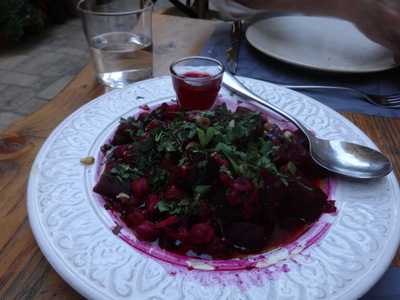
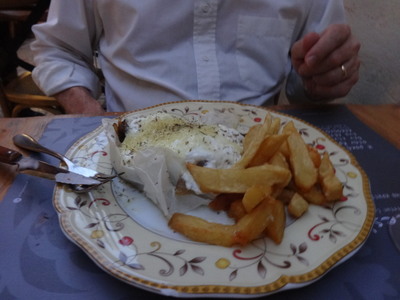 We decided to split an appetizer: a salad of chick peas and beetroot with garlic (originating, the menu said, with the ancient Greeks). It was great! It was served warm, heavily strewn with chopped fennel and parsley, sprinkled with crushed walnuts, and accompanied by a little glass of olive oil, already dyed bright red (presumably by contact with beets. Even the chick peas were red all the way through. Yummy.
We decided to split an appetizer: a salad of chick peas and beetroot with garlic (originating, the menu said, with the ancient Greeks). It was great! It was served warm, heavily strewn with chopped fennel and parsley, sprinkled with crushed walnuts, and accompanied by a little glass of olive oil, already dyed bright red (presumably by contact with beets. Even the chick peas were red all the way through. Yummy.
David ordered a dish especially recommended by Richard Warwick—boneless pieces of young goat slow-cooked in a parchment package, then opened and baked briefly under a yogurt and cheese topping. He declared it outstanding.
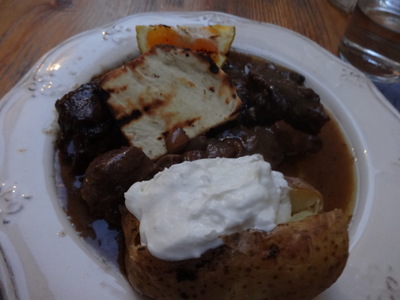
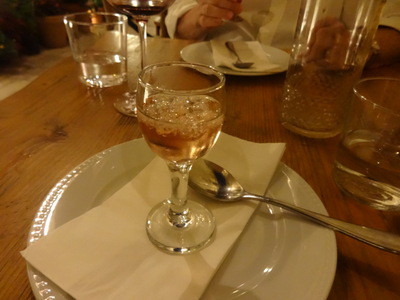 I ordered "pork from Kandanos" (described as "a recipe originating from Minoan Kandanos and till today; slowly cooked pork with wine, fresh orange & onion"). As you can see from the photo, it came accompanied by a quarter of a whole orange that had been grilled on the cut sides and was topped with a quarter of a grilled flatbread. You talk about good! Wow. I don't know whether the sauce included fresh orange, but the grilled orange was terrific with the meat. I cut off slivers of it, peel and all, and ate them with the pork. I'm hoping that recipe is in my new Cretan cookbook; I'll take a shot at it at home. The main difficulty will, of course, be getting pork like that—very dark, flavorful, and succulent. Our pork is mostly too pale and dry.
I ordered "pork from Kandanos" (described as "a recipe originating from Minoan Kandanos and till today; slowly cooked pork with wine, fresh orange & onion"). As you can see from the photo, it came accompanied by a quarter of a whole orange that had been grilled on the cut sides and was topped with a quarter of a grilled flatbread. You talk about good! Wow. I don't know whether the sauce included fresh orange, but the grilled orange was terrific with the meat. I cut off slivers of it, peel and all, and ate them with the pork. I'm hoping that recipe is in my new Cretan cookbook; I'll take a shot at it at home. The main difficulty will, of course, be getting pork like that—very dark, flavorful, and succulent. Our pork is mostly too pale and dry.
Note that both our main courses came accompanied by authenic Minoan potatoes (fries for David; baked and topped with yogurt for me). I'm also pretty sure that sweet oranges hadn't reach the Mediterranean by the time of the ancient Greeks (not until the 15th century, according to Google). I hope both were at least grown on Crete.
After the main courses, we were served tiny glasses of a rose-flavored house-made liqueur, over miniature ice pellets. I actually enjoyed a couple of sips, but it was mostly way to alcoholic for me. Another beverage best enjoy by the spoonful over vanilla ice cream . . .
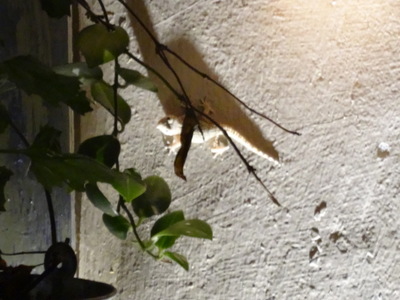
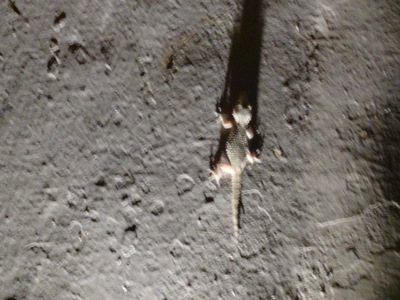 While we sipped our liqueur, this pale little gecko scurried around on the opposite wall of the alley, doing its best to make the world unsafe for mosquitos and other insects. More power to it.
While we sipped our liqueur, this pale little gecko scurried around on the opposite wall of the alley, doing its best to make the world unsafe for mosquitos and other insects. More power to it.
The only disadvantage of sitting in the little alley was that it's a public thoroughfare, so the restaurant can't do anything about the parade of gypsy flower vendors that stroll through, pressing diners to buy roses for their companions. Some were polite about it, others annoyingly persistant.
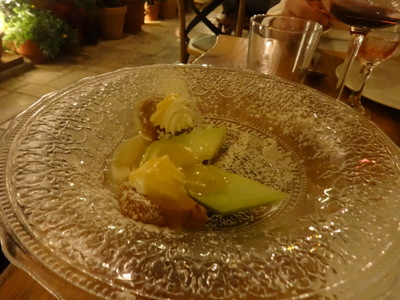 We didn't order dessert, but as Françoise had warned us, they brought us a sweet with the check anyway.
We didn't order dessert, but as Françoise had warned us, they brought us a sweet with the check anyway.
It consisted of two round slices of sesame shortbread (each topped with an herbed cream sauce), two small diamond-shaped slices of melon, and poured over both, a ladleful of cold apple soup. Then a final dusting of confectioners sugar. Delicious!
What a terrific restaurant!
Previous entry
List of Entries
Next entry

 Only one village in southern crete produces wine (I didn't catch the name); all the other grapes we saw on our drive will become sultana raisins. The bright green areas in the foreground in the left-hand photo are grape vines. The rows of darker green spots farther away are olive trees.
Only one village in southern crete produces wine (I didn't catch the name); all the other grapes we saw on our drive will become sultana raisins. The bright green areas in the foreground in the left-hand photo are grape vines. The rows of darker green spots farther away are olive trees.
 As the photo at the left shows, the countryside is heavily cultivated, almost entirely in grapes and olives. Scrubby (but bearing) almond trees were planted around the edges of some olive groves, but I saw no actual almond groves. (We did see one prickly-pear grove, all set out in rows, with drip irrigation lines!)
As the photo at the left shows, the countryside is heavily cultivated, almost entirely in grapes and olives. Scrubby (but bearing) almond trees were planted around the edges of some olive groves, but I saw no actual almond groves. (We did see one prickly-pear grove, all set out in rows, with drip irrigation lines!)
 On crete, the stone age began in the 7th millenium BC and ended in 2600 BC, when the pro-Hellenists brought a new language and contributed place names ending in -os or -is (e.g. Knossos, Phaistos); their leader gave his name to the first site we visited, Gortys (also spelled "Gortyna" and several other variations).
On crete, the stone age began in the 7th millenium BC and ended in 2600 BC, when the pro-Hellenists brought a new language and contributed place names ending in -os or -is (e.g. Knossos, Phaistos); their leader gave his name to the first site we visited, Gortys (also spelled "Gortyna" and several other variations).
 Gortys has more than one claim to fame, from different periods.
Gortys has more than one claim to fame, from different periods. 
 Here (left) is a view of the curved wall bearing the bulk of the preserved inscription. The stones making up the rest of it are scattered. As always, when when an ancient stone structure falls into disuse, people scavanged the stones to use in other construction.
Here (left) is a view of the curved wall bearing the bulk of the preserved inscription. The stones making up the rest of it are scattered. As always, when when an ancient stone structure falls into disuse, people scavanged the stones to use in other construction.
 At the left here, the guide holds up a hand-made chart showing the correpondence between the modern/classical Greek letters and the smaller number of letters used in the great inscription. She gave the chart away to one of the group after talking about it, and it later turned up in the Swedmark Fund raffle!
At the left here, the guide holds up a hand-made chart showing the correpondence between the modern/classical Greek letters and the smaller number of letters used in the great inscription. She gave the chart away to one of the group after talking about it, and it later turned up in the Swedmark Fund raffle!
 Here's wider shot of the odeon. The great inscription is inside the brick structure, and the white band across the hillside behind it (view bounded on both sides by trees) is the remains of the seating of the larger theater.
Here's wider shot of the odeon. The great inscription is inside the brick structure, and the white band across the hillside behind it (view bounded on both sides by trees) is the remains of the seating of the larger theater.
 Here, at the left, is a view of the ruins of the palace of Phaistos as you approach the site on foot. The whole thing is located on the top of the Hill of Castri, documented to be the hottest site on Crete, and the weather was trying to convince us of that. Fortunately, it's also quite windy, so we had a nice breeze. The rooftops are shelters built to protect parts of the ruins. At Knossos, I'm told, considerable areas of the palace have been reconstructed, but here at Phaistos, the emphasis has been only on stabilizing and preserving. In fact, some of the areas we walked on had been excavated, studied, and then covered up again.
Here, at the left, is a view of the ruins of the palace of Phaistos as you approach the site on foot. The whole thing is located on the top of the Hill of Castri, documented to be the hottest site on Crete, and the weather was trying to convince us of that. Fortunately, it's also quite windy, so we had a nice breeze. The rooftops are shelters built to protect parts of the ruins. At Knossos, I'm told, considerable areas of the palace have been reconstructed, but here at Phaistos, the emphasis has been only on stabilizing and preserving. In fact, some of the areas we walked on had been excavated, studied, and then covered up again.
 Next, we walked through the storage area of the palace. Small, windowless, stone-walled rooms lined both sides of a corridor. Most of them were empty, but a couple, shown here, have been restored to their original conjectured arrangement—that is, the same jars that were there when they were found have been put back, in the same places.
Next, we walked through the storage area of the palace. Small, windowless, stone-walled rooms lined both sides of a corridor. Most of them were empty, but a couple, shown here, have been restored to their original conjectured arrangement—that is, the same jars that were there when they were found have been put back, in the same places. 
 The left-hand photo here shows the Minoan equivalent of those big folding room dividers that can be used to separate cavernous hotel ballrooms into three or four smaller meeting rooms.
The left-hand photo here shows the Minoan equivalent of those big folding room dividers that can be used to separate cavernous hotel ballrooms into three or four smaller meeting rooms.
 Françoise was pretty disgusted when she heard that our day's excursion would end up at Matala—"They're not taking you to Knossos, but they're taking you to see the stupid hippie caves?!" Not knowing anything about our destinations at the time, we assured her that they were probably taking us to a place of interest to meiofauna collectors, like a beach with plenty of nematodes and copepods. As it turned out, of course, Gortys and Phaistos were the real point of the trip. Matala, with its "stupid hippie caves," was just where we got the chance to have lunch, shop a little, and for those who wanted to, go swimming in the sea.
Françoise was pretty disgusted when she heard that our day's excursion would end up at Matala—"They're not taking you to Knossos, but they're taking you to see the stupid hippie caves?!" Not knowing anything about our destinations at the time, we assured her that they were probably taking us to a place of interest to meiofauna collectors, like a beach with plenty of nematodes and copepods. As it turned out, of course, Gortys and Phaistos were the real point of the trip. Matala, with its "stupid hippie caves," was just where we got the chance to have lunch, shop a little, and for those who wanted to, go swimming in the sea.
 What we did was to prospect restaurants until we found one that suited us (Alexis Zorba's Family Taverna) and settle in for a leisurely lunch with a colleague.
What we did was to prospect restaurants until we found one that suited us (Alexis Zorba's Family Taverna) and settle in for a leisurely lunch with a colleague.
 David and Michaela both ordered Greek Salad, which, in Greece, never contains lettuce. It's just tomato, cucumber, optional bell peppers and onions, and feta, with some oregano and a light vinaigrette.
David and Michaela both ordered Greek Salad, which, in Greece, never contains lettuce. It's just tomato, cucumber, optional bell peppers and onions, and feta, with some oregano and a light vinaigrette.


 Bread was served in wooden boxes with hinged lids; our table was so small that they put the box on a little stool next to it.
Bread was served in wooden boxes with hinged lids; our table was so small that they put the box on a little stool next to it.
 We decided to split an appetizer: a salad of chick peas and beetroot with garlic (originating, the menu said, with the ancient Greeks). It was great! It was served warm, heavily strewn with chopped fennel and parsley, sprinkled with crushed walnuts, and accompanied by a little glass of olive oil, already dyed bright red (presumably by contact with beets. Even the chick peas were red all the way through. Yummy.
We decided to split an appetizer: a salad of chick peas and beetroot with garlic (originating, the menu said, with the ancient Greeks). It was great! It was served warm, heavily strewn with chopped fennel and parsley, sprinkled with crushed walnuts, and accompanied by a little glass of olive oil, already dyed bright red (presumably by contact with beets. Even the chick peas were red all the way through. Yummy.
 I ordered "pork from Kandanos" (described as "a recipe originating from Minoan Kandanos and till today; slowly cooked pork with wine, fresh orange & onion"). As you can see from the photo, it came accompanied by a quarter of a whole orange that had been grilled on the cut sides and was topped with a quarter of a grilled flatbread. You talk about good! Wow. I don't know whether the sauce included fresh orange, but the grilled orange was terrific with the meat. I cut off slivers of it, peel and all, and ate them with the pork. I'm hoping that recipe is in my new Cretan cookbook; I'll take a shot at it at home. The main difficulty will, of course, be getting pork like that—very dark, flavorful, and succulent. Our pork is mostly too pale and dry.
I ordered "pork from Kandanos" (described as "a recipe originating from Minoan Kandanos and till today; slowly cooked pork with wine, fresh orange & onion"). As you can see from the photo, it came accompanied by a quarter of a whole orange that had been grilled on the cut sides and was topped with a quarter of a grilled flatbread. You talk about good! Wow. I don't know whether the sauce included fresh orange, but the grilled orange was terrific with the meat. I cut off slivers of it, peel and all, and ate them with the pork. I'm hoping that recipe is in my new Cretan cookbook; I'll take a shot at it at home. The main difficulty will, of course, be getting pork like that—very dark, flavorful, and succulent. Our pork is mostly too pale and dry.
 While we sipped our liqueur, this pale little gecko scurried around on the opposite wall of the alley, doing its best to make the world unsafe for mosquitos and other insects. More power to it.
While we sipped our liqueur, this pale little gecko scurried around on the opposite wall of the alley, doing its best to make the world unsafe for mosquitos and other insects. More power to it. We didn't order dessert, but as Françoise had warned us, they brought us a sweet with the check anyway.
We didn't order dessert, but as Françoise had warned us, they brought us a sweet with the check anyway.